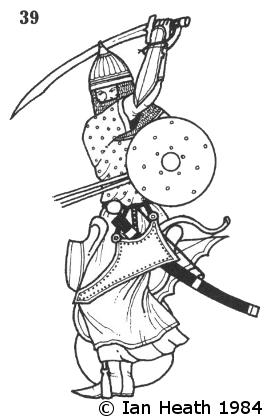MOSLEM INDIAN CAVALRYMAN c.1400
An extract from Armies of the Middle Ages, Volume 2
by Ian Heath
[Based on a Zafarnama of 1436]

|
|
|
39. MOSLEM INDIAN CAVALRYMAN c.1400
Barbosa describes Moslem cavalry of Delhi, Gujarat and the Deccan as riding high-pommelled saddles and wearing mail corselets or ‘short jackets quilted with cotton’.
He says each man was armed with a long, light lance which had a ‘4-sided iron head a cubit long and very strong’, 2 swords (‘each with its dagger’), 2 or 3 Turkish bows with ‘very long arrows’, plus sometimes a steel mace and battle-axe, ‘so that every man carries arms enough for 2’.
In addition he records that they ‘carry strong round shields covered with silk’, doubtless kalkans (see note to figure 27).
The cavalry of Delhi he particularly regarded as being ‘very strong and good archers’, while he noted that those of the Deccan ‘fight tied to their saddles’ and, along with the Moslems of Gujarat (and presumably Delhi), made ‘much use of whips’ when riding, which would imply that they did not have spurs, even though at least one source (Qalqashandi) records that they did.
Basic costume comprised Tartar coats, Islamic coats from Khwarizm, small turbans, 4-cornered hats, trousers and tunics of silk, cotton, cloth of gold and camlets (a mixture of silk and wool), plus knee-length boots of thick leather and silver and gold belts.
Some of the coats had gold-embroidered tiraz bands on the sleeves, while the coats of the nobility were usually of heavily-embroidered gold brocade (briefly banned under Firuz Shah Tughluq as ‘unlawful’).
In addition the saddles of the nobility were decorated, as were their swords, the latter being damascened in gold and silver according to the rank of their owners.
In the mid-14th century al-‘Umari says that the ‘Turkish slaves’ (ie, the mamluks) of the sultan of Delhi’s army were issued with 4 uniforms a year, those worn in winter coming from Alexandria, those worn in summer being of woven cloth from India, China and Iraq, which was fine, shiny and heavily-embroidered like ‘the robes of Baghdad’.
Elsewhere he adds that ‘the entire army has excellent horses and magnificent armour, in addition to fine military uniforms.’
Qalqashandi too mentions uniforms, and records in addition that the soldiers of Delhi wore their hair plaited with silk tassels.
The figure illustrated here comes from a picture dating to 1436 depicting the Battle of Delhi in 1398.
His armour comprises an iron helmet with a gilt brow-band, a mail hood, bazubands with extensions to protect the backs of his hands, and a long, green coat of which the upper portion and the sleeves are studded with gilt rivet heads, denoting a plate lining.
The tunic he wears under his armour is red, boots are grey, scabbard black with gold fittings, bowcase blue and shield red with an iron boss and gilt rivets.
Lances where carried are about 12 feet in length with blue, red, green or mauve triangular pennons.
In the original he rides an armoured horse.
Persian-style armour was probably introduced into India around the beginning of the 14th century, its evolution thereafter following a similar course.
Next: 40. INDIAN PARASOL-BEARER in Armies of the Middle Ages, Volume 2 by Ian Heath
Illustrations of Sultanate of Delhi soldiers of 1450:
Rustam Kills the Turanian Hero Alkus with his Lance
Gushtasp Slays the Dragon
Rustam Grieving for His Son
Siyavash faces Afrasiyab across the Jihun River
Siyavash is Pulled from His Bed and Killed
Vijayanagar Illustrations and Articles
Mughal Illustrations of Costume & Soldiers

